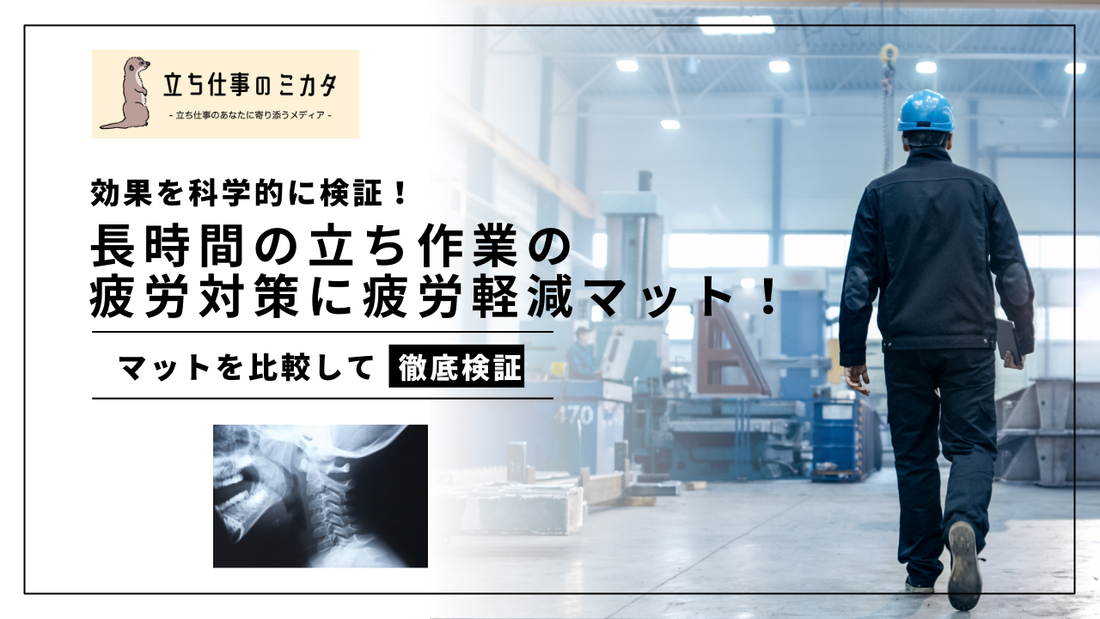
Fatigue-reducing mats to combat fatigue caused by long hours of standing at work! Scientifically verified effectiveness
Share
Introduction
Standing for long periods of time is unavoidable in many occupations. Many people, including medical professionals, factory workers, teachers, and salespeople, work in environments that require them to stand for long periods of time. However, standing for long periods of time can increase strain on the feet, knees, and hips, causing fatigue and pain. Therefore, as a way to improve the work environment, "Anti-Fatigue Mats" The use of is attracting attention.
In this article, we will provide a scientific explanation of the effects of anti-fatigue mats on standing work, based on the research of Wiggermann & Keyserling (2013).

What is a fatigue reduction mat?
Anti-fatigue mats are flooring materials designed to reduce fatigue and discomfort caused by standing for long periods of time. They generally have the following characteristics:
- Flexible and cushioned
- Distributes pressure on the soles of the feet and relieves muscle tension
- Absorbs shock and reduces strain on joints
However, there hasn't been enough research done to see if these mats are really effective or to what extent they make a difference.
Research Summary
This study had two main objectives:
- Evaluating the effect of anti-fatigue mats on discomfort
- To investigate the relationship with behavioral changes (e.g., frequency of weight shifting)
Research Methods
- Participants : 10 people (5 men and 5 each)
-
Experimental environment :
- Four types of commercially available anti-fatigue mats (different materials and hardness)
- Linoleum on concrete (control)
-
Test Contents :
- Each participant stood for four hours on a different surface.
- Discomfort assessed every 55 minutes (by body part: feet, knees, hips, etc.)
- Pressure sensors in the shoes measure the frequency of weight-shifting

Research findings
1. The effect of fatigue reduction mats
- After four hours of standing, the three types of fatigue-reducing mats were found to reduce discomfort compared to the linoleum floor (control group).
- However, there were no significant differences between the mats , so it was not possible to identify a "most effective mat."

The results showed that the anti-fatigue mats (A, B, C) caused significantly less discomfort than the hard floor (linoleum on concrete), but no significant differences were found between the mats.

The results showed that the softest mat (A) and the hardest mat (D) significantly reduced discomfort compared to the linoleum flooring .
2. Weight-Shifting
- The frequency of weight shifting was correlated with the hardness of the floor , with weight shifting increasing on harder floors (Figure 1).
- Increased weight transfer was also found to be associated with increased leg and lower back discomfort.


3. Discomfort assessment
- Discomfort in the feet, calves, and lower back varied significantly depending on the type of flooring (Figure 2).
- However, no significant differences were found in thigh or whole-body discomfort .

The results showed that only the softest mat (A) significantly reduced discomfort compared to the linoleum floor .

The results show that the frequency of weight shifting was highest on the hardest mat (D) and lowest on the softest mats (A and B) . This suggests that the hard floor increases discomfort and causes people to unconsciously shift their weight more frequently.

Results showed that higher foot discomfort scores were associated with increased frequency of weight shifting .
Observations
Fatigue reduction mats are effective, but the effectiveness varies from person to person
The study confirmed that anti-fatigue mats were effective in reducing discomfort , but it was unclear which mat was most comfortable , suggesting that it may depend on personal preference .
Importance of behavioral indicators (weight transfer)
Because discomfort evaluations vary from person to person, it was shown that the frequency of weight shifting is a more effective objective evaluation index . On hard floors, people unconsciously shift their weight more, which can intensify discomfort.
Workplace Applications
- When selecting the most suitable fatigue reduction mat , it is necessary to consider not only the flexibility of the material but also the feel and preferences of each individual worker.
- Standing for long periods of time can cause fatigue, so it is important to take regular breaks and sit down during work .
summary
- Fatigue reduction mats can reduce discomfort caused by standing for long periods of time .
- While the differences between different types of mats are not statistically clear, they are definitely more comfortable than hard floors .
- The frequency of weight shifting is related to discomfort and is a useful behavioral indicator .
- In order to improve the working environment, in addition to introducing mats, it is essential to introduce seated work and ensure breaks .
Suggestions for improving the workplace
✅ Introducing anti-fatigue mats : Essential especially when working on hard floors✅ Select the right mat : Consider individual comfort and test implementation ✅ Measures to reduce the strain of standing work : recommending sitting work, stretching, and appropriate breaks

